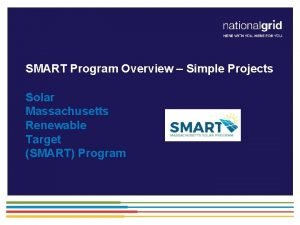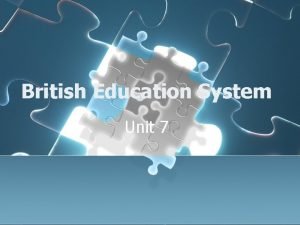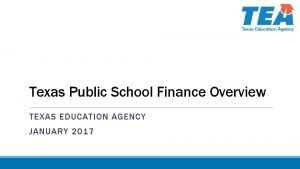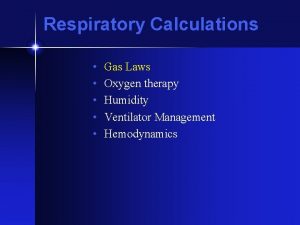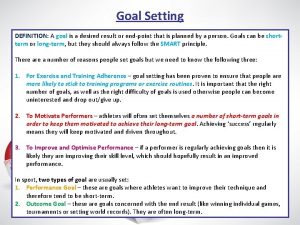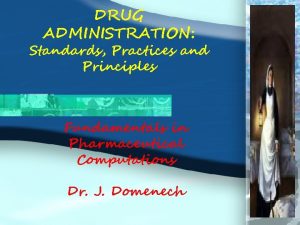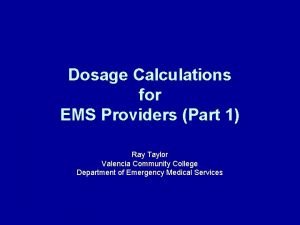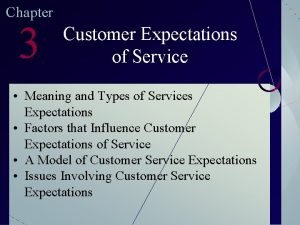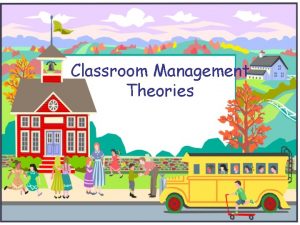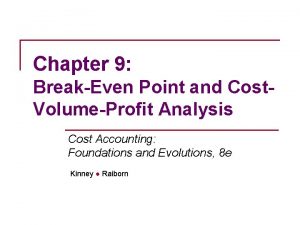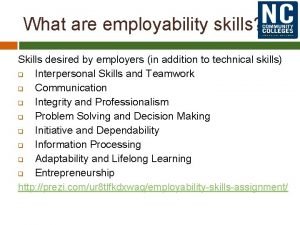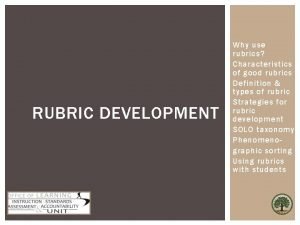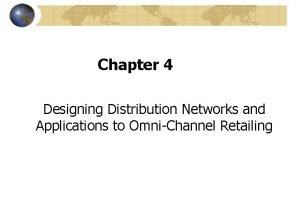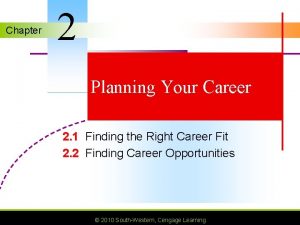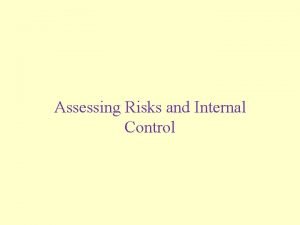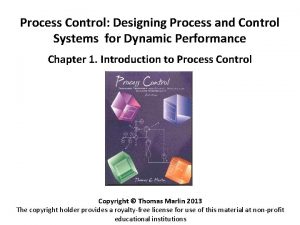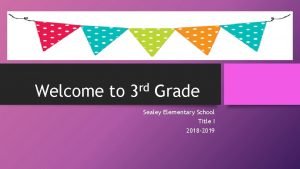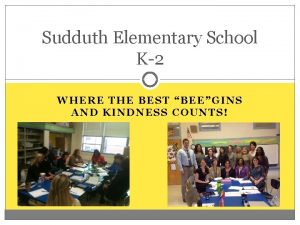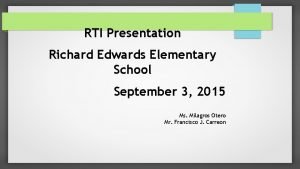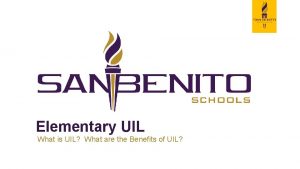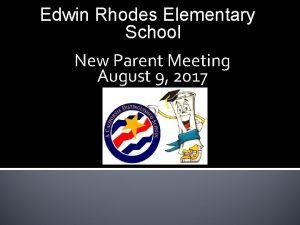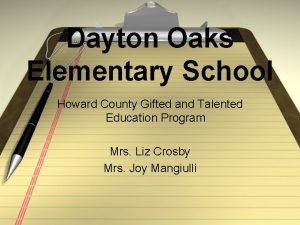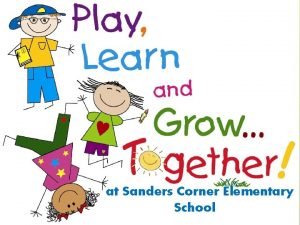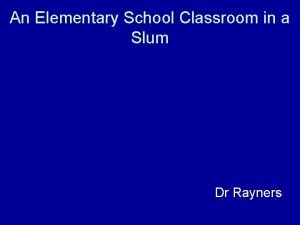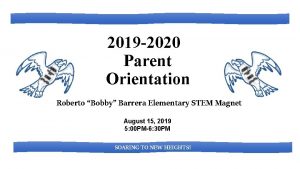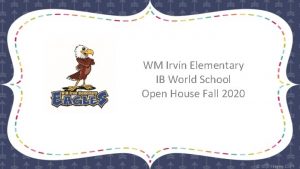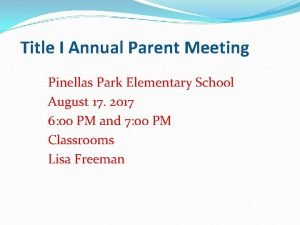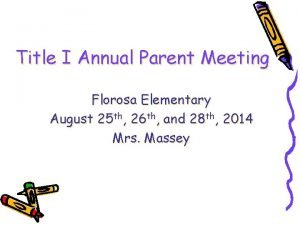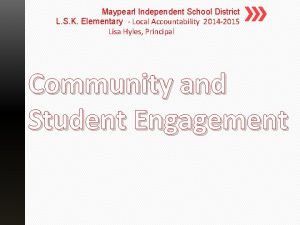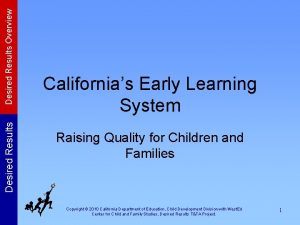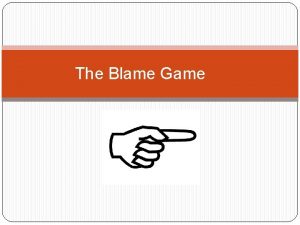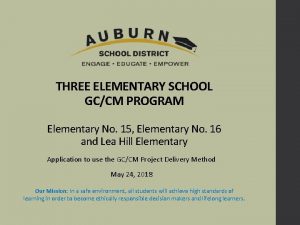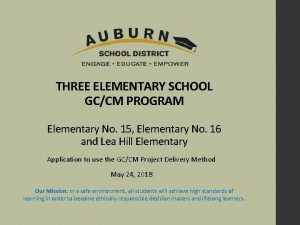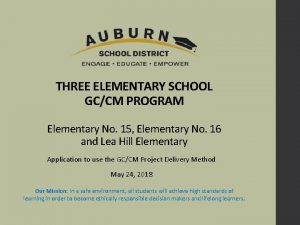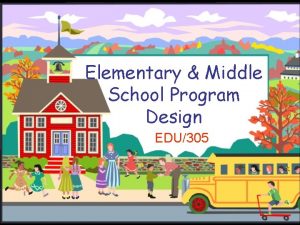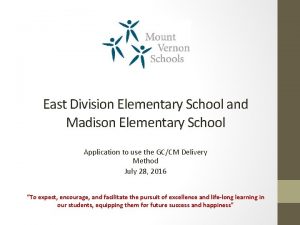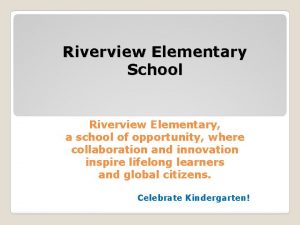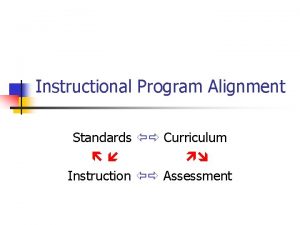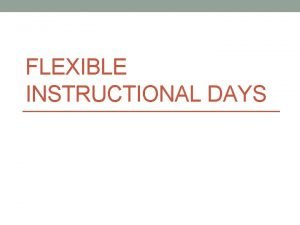Winterfield Elementary School Instructional Program Overview Desired Outcomes



































































- Slides: 67

Winterfield Elementary School Instructional Program Overview

Desired Outcomes � At the end of the session, teachers will: ◦ Understand the urgency of increasing the level of rigor/challenge in our school. ◦ Collaborate with administration and colleagues to design rigorous instruction, assignments, and assessments while providing support for one another and our students. ◦ Create classroom cultures that support and nurture high academic achievement for all learners.

Working Agreements � Become and remain open to new ideas � Be fully engaged and present � Honor time agreements � Speak your truth respectfully � Share responsibility for the success of our work together � Silence/vibrate all technology

What is Teaching? � Guiding student thinking in deliberate ways along a structured route engineered for thinking and learning. � Causing mental acts within students’ heads that will result in their understanding or being able to do something. � It’s about the learning, not the teaching! Source: The Skillful Teacher (Sapier, Haley-Spec, Glower)

Special Announcement

What is Teaching? � Teaching is a valuable profession with clear standards and expectations. � Teaching is a craft that must be constantly be reassessed, revised and refined. � Teaching is the most important part of maintaining our civilization. � Teaching is an art. � Teaching is a science. � Teachers can get better if they are honest with themselves and willing to grow.


Grant’s Key Beliefs About Being an Educator � EVERY child and EVERY teacher can learn, grow, and excel in the right environment. � Everyone is important: Every child deserves an EXPERT teacher Every teacher deserves to be a part of an EXPERT community. Every school needs adults who can pool their intelligence to help the entire school get smarter. � Working in a high poverty school is hard work, but coming to work should be a joy…EVERYDAY. � Teachers should freely participate in professional development, welcome feedback, and work hard to increase their effectiveness. � A family atmosphere is the best way to nurture teachers and grow students.

Ms. Grant’s Beliefs About Teaching & Learning • Every child can learn at HIGH levels. • No excuses • Maintain a growth mindset • Don’t blame the lettuce

Ms. Grant’s Beliefs About Teaching & Learning • Push them, scaffold when necessary • Great teaching is intentional, not accidental—You have to plan it and plan it well! • The most important thing is the teacher and what he/she can do…


What is your view of intelligence?

A quick quiz… Agree/Disagree A. Your intelligence is something very basic about you that you can’t change very much. B. You can learn new things, but you can’t really change how intelligent you are. C. No matter how much intelligence you have, you can always change it quite a bit. D. You can always substantially change how intelligent you are.

A Word About Mindsets Intelligence is fixed � You get what you get � Ability is primary � Failure=confirmation of lack of ability/smartness � Goal: Prove I am smart or hide the truth � Feedback is criticism � Fixed Mindset � Intelligence is malleable � You can get smarter � Effort is primary � Failure=opportunity to learn from mistakes � Goal-to learn and improve � Feedback is help Growth Mindset

A 2 nd quick quiz Agree/Disagree A. Your ____ ability is something very basic about you that you can’t change very much. B. You can learn new things, but you can’t really change how well you _______. C. No matter how much ____ ability you have, you can always change it quite a bit. D. You can always substantially change how well you _____.

Star teachers have a growth mindset

Key Cultural Messages �This is important �You can do it, with effective effort �I won’t give up on you

We Don’t Blame the Lettuce When you plan lettuce, if it does not grow well, You don’t blame the lettuce. You look for reasons it is not doing well. It may need fertilizer, or more water, or less sun. You never blame the lettuce. --Thich Nhat Hahn

Key Cultural Messages � Praise effective effort, not smartness � Emphasize the use of skills instead of traits � Graph student effort/effort rubrics � Explicitly teach resiliency and efficacy

Break Time!

ROUTINES & PRACTICES-The Big 7 � Post and share teaching points/objectives for every subject, every day. ◦ Verbally state teaching points and/or objectives prior to beginning instruction. ◦ Refer back to the teaching point and/or objectives several times during the instructional period. ◦ Align all instructional activities directly to the teaching point and/or objective.

ROUTINES & PRACTICES-The Big 7 � Deliver ◦ ◦ ◦ effective instruction by: Framing the big picture Using clear explanatory devices Creating mental engagement Providing cognitive empathy and Anchoring learning.

Frame the Big Picture � Communicate the teaching point/objective. � Share the learning itinerary-post the agenda on the board. � Connect the teaching point/objective to an essential question. � Explain the reason for the learning task/activity. How is it connected to the teaching point/objective? � Share why the teaching point/objective is important for students to learn (Attention) � Share the criteria for success.

Board Expectations � Teaching point/Objectives � Learning Task � Agenda

Example of Framing… � Mathematicians, � First today I am going to teach you… we will… � Then… � Finally… � After today’s teaching, you should have/understand… � The reason this is important… � The activities we will do today are important… � Here is what you need to do to show you have met the standard…

Example of Framing… � � Teachers, today I am going to teach you how to frame a lesson. ◦ First I will share the knowledge base for framing a lesson. ◦ Then we will practice converting CC objectives into a teaching point. ◦ Then you will share your learning with a table buddy. ◦ Finally we will discuss next steps for successfully implementing our new learning into our daily lessons. After today’s training, you should have/understand how framing a lesson can increase student attention and ultimately their engagement. The reason lesson framing is important is that our students need a clear focus free of information that can decrease their opportunities to learn. The activities we will do today are important so you get comfortable with framing. Here is what you need to do to show you have understand how to frame a lesson. Practice framing a lesson with a table buddy and include all important parts of lesson framing in your presentation.

Task: Script a Framing for a routine or procedure � Think of a routine or procedure that you will teach on the 1 st day of school. � Write a frame of the lesson. � Share your frame with a colleague.

Example of Framing… � Mathematicians, � First today I am going to teach you… we will… � Then… � Finally… � After today’s teaching, you should have/understand… � The reason this is important… � The activities we will do today are important… � Here is what you need to do to show you have met the standard…

Clear Explanatory Devices � Explanatory devices are tools that can be used to present information and explain concepts within any approach to teaching. ◦ Learners take in information in 3 Ways: �Auditory �Visually �Kinesthetically �Be sure to explain in ways that allow students to SEE, HEAR, and EXPERIENCE the content or concept.

Clear Explanatory Devices � Simple and progressive cues � Simple language � Analogies � Diagrams � Pictures � Charts, Whiteboard, Smartboard � Document cameras � Audio and Video � Models � Mental Imagery � Think Alouds � Graphic Organizers

Clear Explanatory Devices � Content Device) + How We Explain it (Explanatory ◦ This is the GUM!

Mental Engagement � Make cues explicit, instead of “guess what I am thinking? ” or “guess why we are doing this? ” � Ask clear questions, instead of “read my mind” ◦ What is good writing? ◦ Avoid questions in a series if you are trying to clarify your original question. Ask a clear question. � Give necessary steps in directions, instead of “Oops I left that out” � Give the meaning of references, instead of “who is she talking about”.

Cognitive Empathy � Checking for Understanding � Unscrambling Confusions � Making Thinking Visible

Anchoring Learning � Summarizing ◦ ◦ Learning What did I learn today? What puzzled me? What did I enjoy, hate, accomplish in class today? How did I learn from the discussion or lesson? How was my performance in class? � Use of Questioning

Effective Instruction Summary � Frame the lesson � Explain clearly � Create, maintain and sustain engagement � Get in their Heads/Ensure they learning � Anchor it so it sticks!

ROUTINES & PRACTICES-The Big 7 � Provide clear and concise directions for instructional tasks. ◦ ◦ Visual Oral/Verbal Have a student share Write your directions in advance to ensure you use precise, explicit language

ROUTINES & PRACTICES-The Big 7 � Pre-teach and reinforce academic vocabulary necessary for understanding. ◦ Ex. CELL Strategies ◦ What academic words are important to understanding?

ROUTINES & PRACTICES-The Big 7 � Share and review criteria for scholar work products before learning tasks are distributed. ◦ What is the target? What performance level is expected for mastery? ◦ What is the rubric? What does success look like? ◦ Can you share example work? Is it posted? ◦ Are your expectations clear?

ROUTINES & PRACTICES-The Big 7 � Use questions, prompts, and cues strategically to guide scholars to deeper understanding AND require all scholars to provide evidence (oral and written) to support their thinking. ◦ Pre-plan your questions to ensure higher level thinking and necessary scaffolding. ◦ How do I cue? How do I prompt?

ROUTINES & PRACTICES-The Big 7 � Assess scholar understanding at the end of each lesson AND use scholar performance data to plan upcoming instruction. ◦ ◦ ◦ How will you pre-assess? Exit tickets? End of lesson assessment tied to the objective? Can you prove they met the target? Respond to performance.

ROUTINES & PRACTICES-The Big 7 � The Big 7 will be the focus of our school-wide professional learning this year. � The Big 7 are not tied to any particular instructional program or product; it is just about good old-fashioned teaching.

Expected Instructional Strategies To ensure all scholars are able to master required content, teachers are expected to incorporate the following instructional strategies into their repertoire. Training and support will be provided in these areas throughout the year.

Break Time!

What Do We Teach? � Each grade level will receive a WES Curriculum Map that outlines what to teach when! ◦ Includes a year-long outline of units ◦ A monthly pacing calendar that can be adjusted by teacher teams. ◦ Will support the special area team

Balanced Content � We ◦ ◦ ◦ ◦ teach… Reading Writing Spelling Math Science Social Studies Special Areas…

What is the Schedule? � We have designed a master schedule around the needs of our students. � 60 Min. of Readers Workshop (inc. SS) � 60 Min. of Math � 45 Min. of Writers Workshop � 45 Min. of Science � 30 Min. of Reading Support � 30 Min. of Math Support � 55 Min. of Special Area classes (5 Day Rotation)

Understand… � Actors do not teach children, teachers do � Programs do not teach children, teachers do � Technology does not teach children, teachers do � Worksheets do not teach children, teachers do � Video clips do not teach children, teachers do

My Classroom? � Every child was scheduled by hand � Organizing levels of teacher support based upon students needs: ◦ ESL Services ◦ EC Services ◦ Facilitator Co-teaching, demonstration and modeling. ◦ Potential hiring of additional co-teachers

Support Time? � Reading Support ◦ Leveled Literacy Intervention ◦ Guided Reading ◦ Book Clubs � Math Support ◦ Time Tech Swap (ixl. com and Dreambox) ◦ Guided Math Support

Technology for Time Swap? � We have ordered an additional 90 Chrome Books! ◦ Every 3 rd-5 th grade classroom will have 10 Chrome Books assigned all day, every day. ◦ Personalized learning and support � We plan to order more i. Pads! ◦ Every K-2 nd grade classrooms will ultimately have an assigned 10 i. Pads to support personalized learning and support.

Ms. Grant’s Beliefs About Lesson Planning � Great teaching doesn’t happen on the fly. � The level of detail in a plan should match the teachers needs, not an administrator. � There are important components that must be included in your plans. � Questions have to be pre-planned. � Checks for understanding have to be preplanned. � Assessment has to be pre-planned � All activities MUST be aligned to the teaching point/objective.

Lesson Plan Requirements � Each grade level can decide on the format of plans. � Required components ◦ Teaching point/Objectives ◦ Connection, Teach, AE, and Link ◦ ◦ �Clearly outline the direct instruction component of all plans Differentiation (small group/conferring) Exit assessment Checks for Understanding Technology use? � Submission requirements: ◦ Post on google drive by 5 p. m. on Friday. ◦ Use google drive to collaborate on lesson plans but, align the plans to the needs of your students.

PLC and Individual Planning �Monday and Tuesday: PLC meetings focused on refining instruction, practicing delivery of instruction, and responding to student data. �Wednesday-Friday: Individual planning—writing of lesson plans, gathering of materials, designing projects, etc.

Lesson Plan Feedback � Members of the administrative and/or facilitator team will provide timely, supportive feedback on lesson plans.

What Not to Say to a Teacher

Data Driven Instruction @ Winterfield Elementary School

Desired Outcomes � At the end of this session, all WES teachers will have an understanding and clarity regarding the expectations for data driven instruction for the 2014 -2015 school year.

What Have I Learned… � Multiple data trackers for the same information � Data tracking seemed like busy work, detached from my real work every day. � It takes to much time away from what I do. � Just let me teach…

What is the Target?

What data is important to monitor? �The Bear Pathway ◦ Clear guidelines on E. O. Y. expectations in reading, writing and math for every grade level.

No Excuses!

What data is important? � Reading � Writing Assessments � Pre/Post Math Assessments 3 D/TRC or Fountas & Pinnell � MAP � Writing Assessments � Pre/Post Assessments K-2 nd 3 rd-5 th � MAP 3 D/TRC � Reading

What am I responsible for tracking? Reading 3 D/TRC; no extra tracking. � MAP; no extra tracking. � Running Records; no submission of trackers � Writing Assessments-teachers will track in Mastery Connect. � Pre/Post-teachers will track in Mastery Connect. � Use

What is Mastery Connect?

Mastery Connect Training � The Mastery Connect team will join us on 8/19/2014 to show us how to use Mastery Connect!

How/when will we Assess? �Weekly quiz (2 nd-5 th) �Pre/Post Assessment (2 nd 5 th) rd th �MOCK EOG (3 -5 ) st ◦ End of 1 Quarter

Who writes the Assessments? Literacy Math Science Reading: Grant & Slagle K-2 nd: Kathy Richardson Herring K-5 th: James Grant Writing: Writing Pathways. Lucy Calkins 3 rd-5 th: Hasan
 Japan school hat
Japan school hat Program specific outcomes nba
Program specific outcomes nba Diabetes prevention program outcomes study
Diabetes prevention program outcomes study Sbic program
Sbic program Overview on the national tuberculosis elimination programme
Overview on the national tuberculosis elimination programme Solar massachusetts renewable target (smart) program
Solar massachusetts renewable target (smart) program Texas recapture districts
Texas recapture districts British school system presentation
British school system presentation British school system overview
British school system overview Texas public school finance overview
Texas public school finance overview Tidal volume normal range
Tidal volume normal range Professional image definition
Professional image definition Short term goals definition
Short term goals definition Dose calculation formula for child
Dose calculation formula for child Drop factor formula with example
Drop factor formula with example Lasting service
Lasting service Customer service expectations
Customer service expectations Tidal volume normal range
Tidal volume normal range Sole proprietor advantages and disadvantages
Sole proprietor advantages and disadvantages Glasser classroom management
Glasser classroom management Unit variable cost formula
Unit variable cost formula Assumptions of cvp analysis
Assumptions of cvp analysis Skills desired by employers
Skills desired by employers Hubbart formula
Hubbart formula Characteristics of good rubric
Characteristics of good rubric Duncker diagram
Duncker diagram Retail storage with customer pickup
Retail storage with customer pickup A(n) is a desired end toward which efforts are directed.
A(n) is a desired end toward which efforts are directed. Inherent risk
Inherent risk Process control design
Process control design Mcm package
Mcm package Drdp summary of findings
Drdp summary of findings Ubujan elementary school
Ubujan elementary school Pgcps calendar a day b day
Pgcps calendar a day b day Mckay elementary school
Mckay elementary school Sealey elementary
Sealey elementary Leila davis elementary school
Leila davis elementary school Wexford elementary
Wexford elementary Kistler elementary school
Kistler elementary school Weatherstone elementary
Weatherstone elementary Terry fox elementary school
Terry fox elementary school Sudduth elementary
Sudduth elementary Heathrow elementary school
Heathrow elementary school Richard edwards elementary school
Richard edwards elementary school Lydiksen elementary school
Lydiksen elementary school Hollifield elementary school
Hollifield elementary school Weddington elementary school
Weddington elementary school Frankfort square elementary school
Frankfort square elementary school What is uil in elementary school
What is uil in elementary school Edwin rhodes elementary
Edwin rhodes elementary Dutchtown elementary school
Dutchtown elementary school Clasroomü
Clasroomü Sanders corner elementary
Sanders corner elementary An elementary school classroom in a slum ppt
An elementary school classroom in a slum ppt Poetic devices an elementary school classroom in a slum
Poetic devices an elementary school classroom in a slum Roberto bobby barrera elementary
Roberto bobby barrera elementary Victoriano elementary school
Victoriano elementary school William irvin elementary school
William irvin elementary school Deep run elementary
Deep run elementary Rolling terrace es
Rolling terrace es Title 1 schools pinellas county
Title 1 schools pinellas county Florosa elementary
Florosa elementary Stoneridge elementary
Stoneridge elementary Quispamsis elementary school
Quispamsis elementary school Melissa jones elementary school
Melissa jones elementary school Northgate elementary school
Northgate elementary school Poulakidas elementary school
Poulakidas elementary school Lsk elementary school
Lsk elementary school





